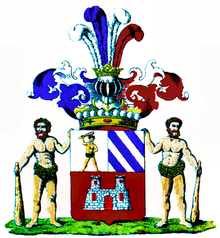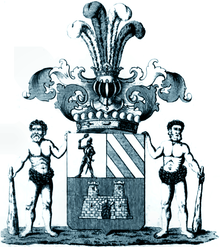Piatti (noble family)
The Counts and Marcheses of Piatti are an old Italian noble family who first entered the service of the Saxon rulers and then gained respect in Austria.
history
The Piatti are a Catholic family, coming from an old Milanese family, of whom two brothers should be mentioned who had embarked on the spiritual path: Ottavio, later Girolamo, Piatti (* 1547 in Milan , † August 14, 1591 in Rome ), Latinized Platus, was an Italian Jesuit , secretary to the Jesuit general Claudio Acquaviva and Flaminio Piatti (* 1548 in Milan, † November 2, 1613 in Rome), Italian prelate , cardinal since 1591 . After that, the family worked for almost 300 years as the Venetian marquise family, who came to Saxony at the time of the Seven Years' War .
First four brothers, the Marquis Carl Alexander, Johann Friedrich, Paul Emil and Caesar, became better known in Saxony. With regard to the parents of these four brothers, outside of the family, it could only be ascertained that the father, born in Italy, lived in 1768 in Rennersdorf near Stolpen , where Johann Friedrich was born, and that his wife Friederike Luise Marquise von Piatti, née Freiin von Erdmannsdorf , (1733–1825) later chief stewardess to the wife of Prince Maximilian of Saxony (1759–1838) , already in 1788 as a widow. It was not possible to find out in what relationship the Electoral Saxon Chamberlain Alexander Maria Marquis Piatti († August 15, 1808 in Dresden), who was still living at the beginning of the 19th century , was. In Bavaria , Caesar Emil Johann Anton Marquis Piatti, († 1827), royal Bavarian chamberlain, was appointed Knight of the Order of St. Michael in 1810.
Carl Alexander Marquis von Piatti (* September 2, 1766; † February 21, 1831) was the Royal Saxon Conference Minister, Lord Chamberlain of the Royal Saxon Court Chamber, Privy Councilor and Chief Chamberlain to Prince Anton of Saxony, holder of the Commander's Cross and Grand Cross of the Royal Saxon Civil Service Cross as well as capitular lord of the Royal Bavarian Order of Merit of St. Michael . He married on August 26, 1815 with Maria Anna Countess of Apponyi (* August 26, 1781, † June 10, 1852). His brother Johann Friedrich (born August 26, 1768, † January 6, 1837) was a royal Saxon chamberlain and colonel of the infantry . Carl Alexander's son Paul Emil continued the family, his brother Caesar (* January 25, 1773; † June 24, 1843) died unmarried as the royal Saxon Privy Councilor and chief steward of Prince Maximilian of Saxony. He was admitted to the Bavarian count on March 26, 1814. The following members of the family are from the third of the brothers mentioned above.
Paul Emil Marquis of Piatti (born December 29, 1771, † September 10, 1834) was the royal Saxon Privy Councilor, chamberlain and chief steward of Prince Maximilian of Saxony. He married on September 26, 1802 Carolina von Dziembowo Pomian Dziembowska (born September 11, 1782). From this marriage came the future head of the family, Friedrich August Graf and Marquis Piatti, (* July 1, 1803; † November 24, 1872) was an Imperial and Royal Chamberlain, lord of the lordships of Loosdorf, Hagendorf and Laa Castle in Lower Austria. July 1830 with Cäcilie Countess von Collalto and St. Salvatore, (born April 30, 1812). The three sons from this marriage were the counts: Eduard Anton Emil, (* April 17, 1831), kk Oberleutnant, Ferdinand Alphons Clemens, (* April 17, 1833), kk lieutenant, and Paul Emil Caesar, (* May 26th 1843). Friedrich August's brother was Clemens, (born August 13, 1817), kk chamberlain, and the widow mentioned above was still living from the brother of Marquis Paul Emil, Marquis Carl Alexander, at that time.
Friedrich August Graf and Marquis von Piatti (* July 1, 1803; † November 24, 1872) was kk chamberlain, member of the Lower Austrian state parliament , Mr. zu Loosdorf in the Weinviertel, Hagendorf and Laa castle in Lower Austria , married on July 1, 1830 with Cäcilie ( * April 30, 1812), Lady of the Star Cross , sister of Prince Eduard von Collalto and San Salvatore. He had the Venetian conte title confirmed for himself and his relatives on April 14, 1829, and on September 29, 1836 he was accepted into the Lower Austrian gentry and his title of march prevalent .
In 1834, the Loosdorf Castle in the Weinviertel passed from Johann I Josef, Prince of Liechtenstein, to the Count Piatti, whose descendants still live in and manage the buildings to this day. The collections of the Piatti family - porcelain, pewter figures and medals - can be admired in the castle museum.
By the highest resolution of February 2, 1841 in Vienna (diploma of September 25, 1842 ibid) he and his descendants were raised to the status of Austrian count by Emperor Franz Joseph I.
Through the marriage of Count and Marchese Manfred Rambald Wenzeslaus Piatti (* July 22, 1924 in Loosdorf), a great-grandson of Friedrich August, with Mechtildis Maria Irene [ Archduchess ] of Austria (* August 14, 1924 in Lissa; † February 18, 2000 in Vienna) as well as the marriage of his younger son Benedikt (born March 21, 1966 in Vienna) to Margherita [Archduchess] of Austria (July 26, 1972 in Munich ), there is a family bond with the House of Habsburg .
With Hans Graf von Fünfkirchen (1889–1970) and his brother Franz de Paula (1892–1965) the noble family of those at Fünfkirchen went out in the male main line. Her sister was Caroline von Fünfkirchen (1890–1980), the last regent of the Savoy women's monastery in Johannesgasse in Vienna. She adopted Manfred's older son Michael, who has been called Michael Graf Piatti-Fünfkirchen (born January 23, 1955) since then .
coat of arms
1841: shield crosswise and divided lengthways in the upper half; shows in the first silver field of the upper half of the shield a forward-looking, wild man girded with leaves, who swings a club over his head in his right hand, but sticks his left hand in his side; in the second field there are three blue oblique bars in silver, and in the lower half there is a stone, grooved fort with two windowed, three-pinned towers and a large gate standing between two windows. The shield is covered by the count's crown, and on top of it rises a crowned helmet, which wears four ostrich feathers, silver, blue, silver, red. The helmet covers are silver and blue on the right, silver and red on the left, and the shield is held by two men girded with foliage who are holding a club on the ground with their free hand.
According to the coat of arms of the Kingdom of Bavaria (Tyroff I 89), there is a forward-looking, armored knight in the first silver field of the upper half of the shield, who holds a so-called morning star in his right hand and lifts the left in his side. The lower half of the shield is silver and the castle is blue.
The Genealogical Pocket Book of the Count's Houses (1848, p. 494) places a wild man holding a club in his hand in the first silver field, three silver right sloping bars in the second blue field, and a stone-colored fort in the third silver field two tin towers and a silver, black grooved round gate.
literature
- Gothaisches Genealogical Pocket Book of the Count's Houses, Julius Perthes Verlag, 44th year, Gotha 1871
- Prof. Dr. Ernst Heinrich Kneschke : "German count houses of the present: in heraldic, historical and genealogical relation", 2nd volume L – Z, Verlag TO Weigel, Leipzig 1853
- Johann Baptist Kranzmayr (Hrsg.): "Wappen-Almanach des Königlich Bayerischen Haus-Ritter-Order of Saint Michael", Munich 1836
See also
- The Beauty of Silence Article on www.schloss-loosdorf.at (PDF; 535 kB)
Web links
Individual evidence
- ^ Edouard-Marie Oettinger: "Moniteur des dates". 3rd volume, Dresden 1867, p. 115
- ↑ Entry in Pierer's Lexicon at www.zeno.org
- ↑ Dr. Georg Hassel: “General European State and Address Handbook for the Year 1816”, 1st volume, 2nd section, Verlag des Landes-Industrie-Comptoirs, Weimar 1817, p. 208
- ^ Genealogical pocket book of the German count's houses for the year 1836, Volume 9, Verlag Justus Perthes, Gotha 1836, p. 576
- ↑ Entry on de.szlachta.wikia.com
- ↑ a b Prof. Dr. Ernst Heinrich Kneschke: "German count houses of the present: in heraldic, historical and genealogical relation", 2nd volume LZ, Verlag TO Weigel, Leipzig 1853, p. 200 f.
-
↑ Small Chronicle of Count Friedrich August Piatti. †. In: Die Presse , November 25, 1872, p. 3 (online at ANNO ). Day = News Count Friedrich August Piatti †. In: Volksblatt für Stadt und Land , November 29, 1872, p. 5 (online at ANNO ).
- ↑ Gothaischer Hofkalender: genealogical pocket book of the princely houses for the year 1867, 104th year, Verlag Justus Perthes, Gotha 1866, p. 140
- ↑ Entry on coresno.com (only accessible with registration)
- ↑ Loosdorf Castle website
- ↑ Entry on geneall.net
- ^ Entry on the website of Fünfkirchen




